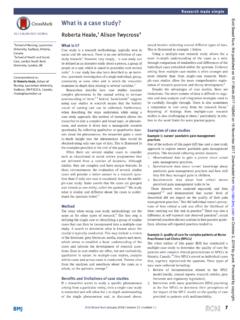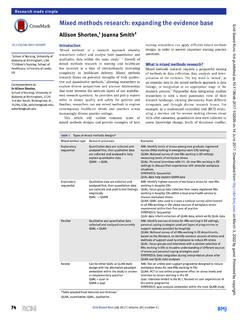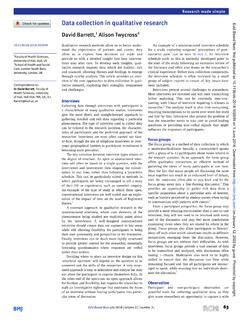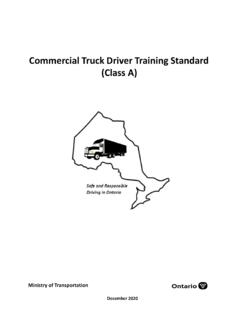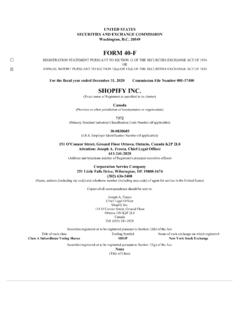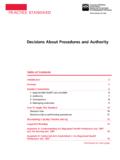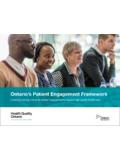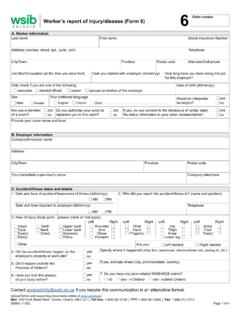Transcription of Triangulation in research, with examples
1 Evid Based Nurs July 2019 | volume 22 | number 3 | 671 School of Nursing and Midwifery, Queens University Belfast, Belfast, UK2 School of Nursing, Laurentian University, Sudbury, Ontario, CanadaCorrespondence to: Dr Helen Noble, School of Nursing and Midwifery, Queen s University Belfast, Belfast BT7 1NN, UK; helen. noble@ qub. ac. ukTriangulation in research, with examplesHelen Noble,1 Roberta Heale2 Research made is triangulationTriangulation is a method used to increase the cred-ibility and validity of research Credibility refers to trustworthiness and how believable a study is.
2 Validity is concerned with the extent to which a study accurately reflects or evaluates the concept or ideas being Triangulation , by combining theories, methods or observers in a research study, can help ensure that fundamental biases arising from the use of a single method or a single observer are over-come. Triangulation is also an effort to help explore and explain complex human behaviour using a variety of methods to offer a more balanced explanation to It is a procedure that enables validation of data and can be used in both quantitative and quali-tative can enrich research as it offers a variety of datasets to explain differing aspects of a phenomenon of interest.
3 It also helps refute where one dataset invalidates a supposition generated by another. It can assist the confirming of a hypothesis where one set of findings confirms another set. Finally, triangu-lation can help explain the results of a Central to Triangulation is the notion that methods leading to the same results give more confidence in the research types of Triangulation are proposed by Denzin ( ):5 (1) data Triangulation , which includes matters such as periods of time, space and people; (2) investi-gator Triangulation , which includes the use of several researchers in a study.
4 (3) theory Triangulation , which encourages several theoretical schemes to enable interpretation of a phenomenon and (4) methodolog-ical Triangulation , which promotes the use of several data collection methods such as interviews and of studies using triangulationBelow, we offer two examples of Triangulation within research studies, providing a context for each study and a description of how Triangulation was used and successfully implemented to ensure an in-depth and more unbiased set of 1 Johnson et al.
5 S6 qualitative study aimed to identify system influences on decision making in a pre-hospital setting with paramedics. Several data sets were included and comprised exploratory interviews with ambulance service staff (n=16); document review observations of paramedic shifts (n=34); paramedic accounts (n=10) via audio-recorded digital diaries ; staff focus groups (n=3) and service user focus groups (n=3) to explore a range of experiences and perceptions. The approach followed Denzin s5 multiple Triangulation approach, which encourages several methods to collect data and multiple investigators with varied I of the study focused on understanding the context of the study and included interviews with ambu-lance service staff and the collection of demographics and local policies.
6 The second phase involved observa-tion of paramedics daily work in order to throw light on decisions related to transporting patients. Focus groups with paramedics, followed by focus groups with service users were then completed in order to share personal experiences of the decisions made by the ambulance service in practice. The final phase included workshops to feed back were coded and thematically analysed. The observations of paramedic shifts identified the complex-ities of the decision-making process related to the context.
7 The observations were supplemented by the interviews and focus groups. Each research method exposed one aspect of This multimethod, multi-disciplinary collaborative research was insightful. It permitted cross-validation, and facilitated exploration, of issues that influenced the decision making of para-medics and concerns and experiences of service 2A study was undertaken to explore the quality of care for patients in a unique model of primary healthcare in Ontario, Canada: the Nurse Practitioner-Led Clinic (NPLC)7.
8 The focus was on the care of patients with diabetes and at least one additional chronic condition, with the assumption that this group of patients repre-sents those with the most complex clinical presenta-tions managed in family practice settings. A multiple case study design was chosen for this research because with this approach, analysis of a variety of data arising from several NPLCs allowed for assumptions to be made about the model as a Additionally, both quali-tative and quantitative research methods were used in the study.
9 Mixing methods is a form of Triangulation in research seen as mitigating the weaknesses found in single first research method was a chart audit, conducted on randomly selected charts of adult patients in five NPLCs who had diabetes and at least one addi-tional chronic condition. The variables included demo-graphic items as well as clinical data related to the care of patients with diabetes. The data were analysed to determine the completeness of the care of diabetes for the second research method was interviews with nurse practitioners (NPs) working at the five NPLCs to determine their perceptions of the quality of care deliv-ered in the NPLC model for patients with diabetes and other chronic conditions.
10 Data from the interviews were analysed using the processes related to an integrative description The draft themes arising from the analysis were forwarded to the participants for their feedback and were confirmed through a review of liter-ature. Finally, a detailed document search was under- on May 19, 2022 by guest. Protected by Based Nurs: first published as on 14 June 2019. Downloaded from Evid Based Nurs July 2019 | volume 22 | number 3 | 68 Research made simpletaken, including but not limited to academic articles, media releases and articles, letters to editor, government policy statements and publications released from the NPLCs.

